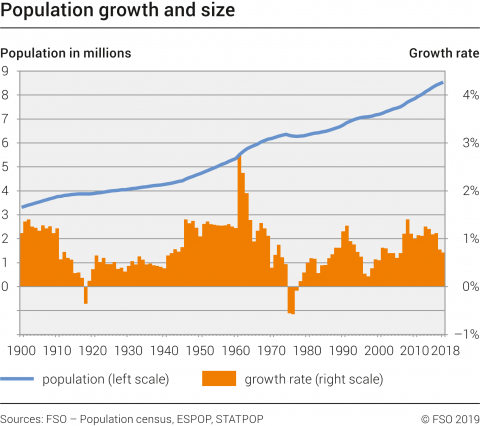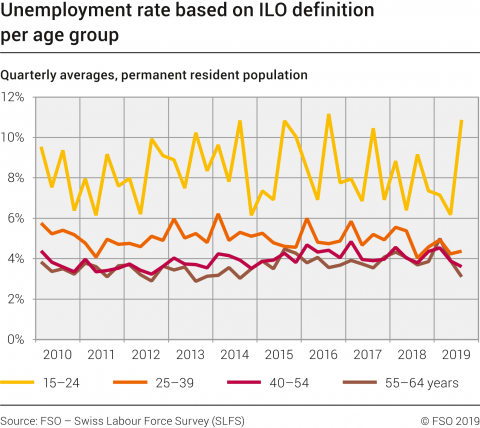Demographic situation
Switzerland covers a total area of 41,285 km2. The productive area, i.e. settled and agricultural areas (not including bodies of water, mountains and non-productive vegetation areas) covers 30,753 km2; just over one quarter of the total area (25.5%) is non-productive. The utilised agricultural area and the forestry area cover 35.9% and 31.3% of the land respectively. The settled area covers 7.5%, with transport infrastructure accounting for around one third.
Switzerland’s three main geographical regions are the Jura, the Central Plateau, and the Pre-Alps and Alps. North of the Alps experiences a largely moderate, central European climate, while the area south of the Alps experiences a Mediterranean climate.
8.5 million people live in Switzerland. The Central Plateau is Switzerland’s economic agglomeration.
84.8% of the population now lives in urban areas: around half of the urban population live in the five largest conurbations (Zurich, Geneva, Basel, Lausanne and Bern).
Source:
Federal Statistical Office (FSO): Territory and environment
Federal Statistical Office (FSO): Population
Demographic development
Since the beginning of the 20th century Switzerland’s population has more than doubled from 3.3 million (1900) to more than 8.5 million.
The population grew by 0.7% in 2018 compared to 2017, passing the 8.5 million mark. The population increase is due to international migration flows and the birth surplus, i.e. a higher number of births than deaths. While emigration rose (+4.2%), immigration fell by 0.5% compared to 2017. Net migration, which is the difference between immigration and emigration, fell by 13.2%. The birth surplus increased over the previous year by 1.7%.

Age structure
The resident population is continuing to age. The proportion of people aged 65 and over rose from 15.4 % in 2000 to 16.0 % in 2005, while the percentage of children and young people under 20 fell from 23.1% to 21.9% in the same period.
In 2018 the proportion of young people under 20 was 20%, the proportion of people aged 20-64 was 61.5%, and the proportion of people aged 65 and over was 18.5%.
In 2018, average life expectancy at birth was 81.7 years for men and 85.4 years for women.

Source:
Federal Statistical Office (FSO): Population: Current situation and change
FSO: Age, marital status, nationality
FSO: Life expectancy
Employment, unemployment
The employment rate (share of gainfully employed people in the population) in the 15-64 age group is 84.2%. The high employment rate is explained by the substantial proportion of part-time workers. Given the high share of part-time workers, the employment rate in terms of full-time equivalents (FTE) is significantly lower than the unadjusted employment rate; the employment rate for people aged 15 to 64 in FTE is 72.8%. The employment rate for women (79.9%) is 8.6 percentage points lower than for men (88.5%).

Unemployment
Between the third quarter of 2018 and the third quarter of 2019, the unemployment rate as defined by the International Labour Office (ILO) rose from 4.4% to 4.6%. 225,000 people were unemployed, some 8,000 more than a year earlier. According to the ILO, the youth unemployment rate (people aged 15 to 24) rose from 9.2% to 10.9% over the same period. The unemployment rate for people aged 25 to 49 rose from 2.9% to 4.1%, while for those aged 50 to 64 it fell from 3.8% to 3.2%. Unemployment rose slightly, from 4.2% to 4.3% for men, and from 4.7% to 4.9% for women. Over the same period, the unemployment rate for Swiss nationals remained stable (3.4%), while for foreigners it increased (from 7.3% to 7.8%).

Source:
Federal Statistical Office (FSO): Employment and working hours
Federal Statistical Officd (FSO): Unemployment, underemployment and vacancies
Migration
In 2018, the population of Switzerland amounted to 8,544,500. With 2,148,300 foreign nationals permanently resident in Switzerland, foreigners account for 25.1% of the population.
The most common countries of origin in 2018 were Italy (14.9% or 319,300 persons), Germany (14.3% or 306,200), Portugal (12.3% or 263,300) and France (6.3% or 134,800). Italian, German, Portuguese and French nationals alone accounted for around three-quarters (72%) of foreigners from an EU/EFTA member state and almost half (48%) of all foreigners permanently resident in Switzerland.

In 2018, 37.5% of the permanent resident population aged 15 and over had a migration background. Just over a third of this population group had Swiss nationality (974,000 people). Four-fifths of the people with a migration background belong to the first generation, while one-fifth was born in Switzerland and is thus part of the second generation.
| In thousand | In % | |
|---|---|---|
| Total | 7165 | 100 |
| Population without a migration background | 4374 | 61,0 |
| Population with a migration background | 2686 | 37,5 |
| 1st generation | 2165 | 30,2 |
| 2nd generation | 521 | 7,3 |
| Persons with undetermined migration background | 105 | 1,5 |
Source:
Federal Statistical Office (FSO): Current situation and change in Switzerland’s population
FSO: Foreign population
FSO: Population by migration status
Languages
Under the Federal Constitution (Art. 4) there are four national languages in Switzerland: German, French, Italian, and Romansh. In 2017, most of the population (62.6%) spoke German, 22.9% French, 8.2% Italian and 0.5% Romansh. The proportion of people who indicate a non-national language as their main language(s) is just over 20%. The total is over 100% because people were allowed to indicate several main languages.
The Federal Act on the National Languages and Understanding between the Linguistic Communities (Languages Act) promotes the individual and institutional multilingualism of Switzerland and strengthens national cohesion. The Languages Act regulates the use of the official languages of the Swiss Confederation, the promotion of understanding and exchange between the language communities, support for the multilingual cantons in fulfilling their special tasks, and support for the cantons of Graubünden and Ticino in preserving and promoting the Romansh and Italian languages and culture.
German, French and Italian are the official languages of the Confederation, i.e. official decrees must be drafted in these three languages. Romansh is an official language of the Confederation when communicating with persons who speak Romansh. The cantons decide themselves on their official languages.
In four cantons (Geneva, Jura, Neuchâtel, Vaud) the official language is French. In three cantons (Bern, Fribourg, Valais) there are two official languages (German and French) and in one canton (Graubünden) there are three official languages (German, Romansh, Italian). In one canton (Ticino) the official language is Italian, in the other 17 cantons it is German.
The language of instruction in schools is laid down by the cantons. As a rule, it is the official language of the place in which the school is located (German, French, Italian or Romansh). In the multilingual cantons one of the national languages is used as the language of instruction depending on the region or commune.
In the German-speaking cantons the spoken language is dialect or vernacular, while the written language is standard German (diglossia). In everyday situations and in local television and radio programmes dialect or vernacular is spoken. Correspondence is written in standard language. The cantons govern the use of dialect and standard German in school teaching, while in most cantons teaching from the first primary school class is mainly in standard German.
Switzerland’s multilingualism makes learning a second national language particularly important. The Swiss Conference of Cantonal Ministers of Education (EDK) has adopted a national strategy for the further development of language teaching in order to coordinate language teaching in compulsory education.
In 1997 Switzerland ratified the Council of Europe’s European Charter for Regional or Minority Languages. The key objectives of the Charter are protecting and promoting linguistic diversity. The Federal Office of Culture is responsible for implementing the Charter.
Source:
Federal Statistical Office (FSO): Languages and religions
Religion
The Federal Constitution guarantees the freedom of religion and conscience (Art. 15): everyone has the right to choose freely their religion or their philosophical convictions, and to profess them alone or in community with others. Everyone has the right to join or to belong to a religious community, and to follow religious teachings. No one may be forced to join or belong to a religious community, to participate in a religious act, or to follow religious teachings.
The cantons are responsible for regulating the relationship between church and state. Most cantonal constitutions recognise the two main Christian denominations, the Roman Catholic Church, and the Protestant Reformed Church, and many cantons also recognise the Old Catholic Church, either as national churches or at least as public religious communities with their own legal personality. Various cantons also provide for the recognition of other denominations. In a minority of Cantons there are no national churches; church and state are completely separate.
In the years 2000 to 2017, 36.5% of the population belonged to the Roman Catholic Church and 24.4% to the Protestant Reformed Church. 6% of the population belong to other Christian communities. 5.2% are Muslims. Hindus, Buddhists, Jews and members of other religions each account for under 1% of the population. 25.0% of the population are non-denominational.
As a result of the freedom of religion and conscience guaranteed by the Federal Constitution attendance of religious instruction at school is not compulsory. The legal status and the content of religious education varies from canton to canton.
Source:
Federal Statistical Office (FSO): Languages and religions

